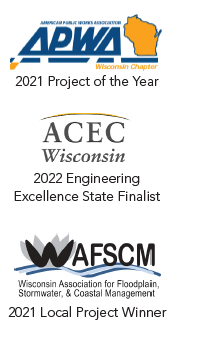City of Kenosha, WI
PROJECT DESCRIPTION
In July 2017, the City of Kenosha endured back-to-back rainfall events that resulted in catastrophic local and regional flooding. This 48-hour event was classified as an approximate 200-year precipitation event, with only a 0.5% chance of occurring in any given year. Five years earlier in 2012, the City partnered with Ruekert & Mielke, Inc. (R/M) and Environmental Resource Associates (ERA) to begin a comprehensive analysis of the City’s storm water infrastructure from both a flood control and water quality perspective, including a 3D flood model and storm water quality model. After the 2017 floods, the data collected from the flood and water quality models allowed R/M to quickly conduct a priority area analysis and evaluate the City’s flooding hot spots. The results of this analysis ultimately led to the following storm water improvement projects.
FORMER KENOSHA ENGINE PLANT (KEP) STORM WATER IMPROVEMENTS
The City partnered with R/M and ERA to construct a 3,920,400 cubic foot flood control facility on the property of a former Kenosha-based engine plant. The project was designed to divert the surcharged storm water flows from the existing 96" storm sewer to attenuate the flows and mitigate upstream flooding. The KEP facility will significantly reduce the recurring flood risk and associated damage to public safety, municipal infrastructure, commercial property investment, and private property within the City and tributary watersheds.
GEORGETOWN STORM WATER IMPROVEMENTS
The north half of the Gangler sub-basin experienced some of the worst flood damage during the July 2017 rainfall events. To directly mitigate the area’s ongoing flood risk, and to improve community surface water quality, the City purchased 6.9 acres of land and constructed a new, 2,178,000 cubic foot storm water detention and flood control facility.
The Georgetown water quality facility will reduce total suspended solids (TSS) by 90% and total phosphorus by 67% in the 170-acre contributing urban drainage area. This will improve the watershed's beneficial uses by lowering the total phosphorus load, increasing dissolved oxygen for fish and other aquatic life, and reducing algae growth for swimming, boating, and other recreational activities. R/M applied for and secured an Urban Nonpoint Source & Storm Water (UNPS&SW) Grant to fund part of the project.
R/M is working with the City to update their water quality master plan following updated DNR guidance and modeling protocols. Before the KEP and Georgetown storm water improvements, the City was achieving an 18.9% TSS reduction. These facilities will help the City achieve its target of 20% reduction in total suspended solids.





